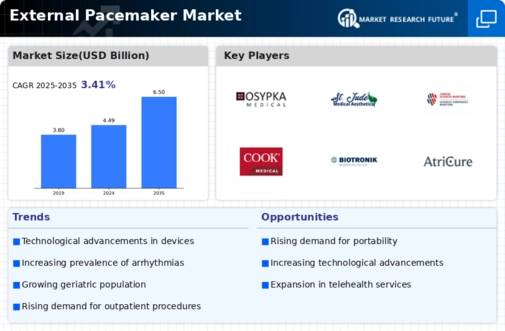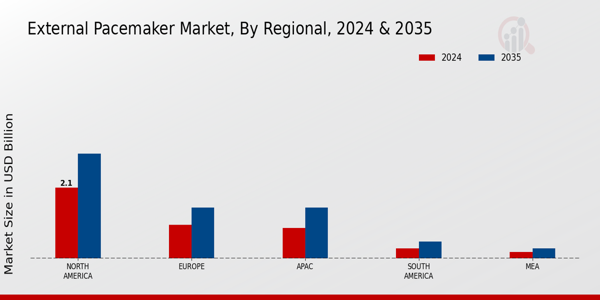Increasing Prevalence of Cardiac Disorders
The rising incidence of cardiac disorders is a primary driver for the External Pacemaker Market. As populations age and lifestyle-related health issues become more prevalent, the need for effective cardiac care solutions intensifies. Data indicates that cardiovascular diseases account for a significant percentage of global mortality rates, prompting healthcare systems to invest in advanced treatment options. The growing awareness of heart health and the importance of timely interventions further contribute to the demand for external pacemakers. This trend suggests that the External Pacemaker Market will continue to expand as healthcare providers seek to address the increasing burden of cardiac conditions.
Regulatory Support and Reimbursement Policies
Supportive regulatory frameworks and favorable reimbursement policies are crucial factors influencing the External Pacemaker Market. Governments and health authorities are increasingly recognizing the importance of cardiac care, leading to streamlined approval processes for new devices. Additionally, reimbursement policies that cover external pacemaker procedures encourage healthcare providers to adopt these technologies. This regulatory environment not only fosters innovation but also enhances patient access to essential cardiac care. As a result, the External Pacemaker Market is likely to benefit from these supportive measures, facilitating growth and encouraging further advancements in device technology.
Growing Awareness and Education on Heart Health
The External Pacemaker Market is positively impacted by the increasing awareness and education surrounding heart health. Public health campaigns and educational initiatives are effectively informing individuals about the risks associated with cardiac diseases and the available treatment options. This heightened awareness is leading to earlier diagnosis and intervention, which is critical for patients requiring external pacemakers. Furthermore, healthcare professionals are being trained to recognize the signs of cardiac issues, thereby improving patient outcomes. As awareness continues to grow, the demand for external pacemakers is expected to rise, further propelling the External Pacemaker Market.
Technological Innovations in External Pacemaker Market
The External Pacemaker Market is experiencing a surge in technological innovations that enhance device functionality and patient outcomes. Recent advancements in miniaturization and battery life have led to the development of more efficient external pacemakers. These devices now offer features such as remote monitoring and programmable settings, which allow healthcare providers to tailor treatments to individual patient needs. According to industry reports, the integration of artificial intelligence in pacemaker technology is expected to improve diagnostic capabilities and patient management. As a result, the demand for technologically advanced external pacemakers is likely to increase, driving growth in the External Pacemaker Market.
Emerging Markets and Expanding Healthcare Infrastructure
Emerging markets are becoming increasingly important to the External Pacemaker Market due to their expanding healthcare infrastructure. As these regions invest in modernizing their healthcare systems, the demand for advanced medical devices, including external pacemakers, is on the rise. Improved access to healthcare services and increased disposable incomes are enabling more patients to seek treatment for cardiac conditions. Additionally, partnerships between local healthcare providers and international medical device companies are facilitating the introduction of innovative technologies. This trend indicates that the External Pacemaker Market will likely see substantial growth in emerging markets as they continue to develop their healthcare capabilities.





















Leave a Comment